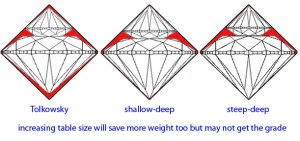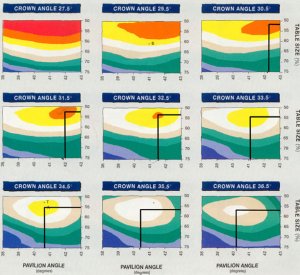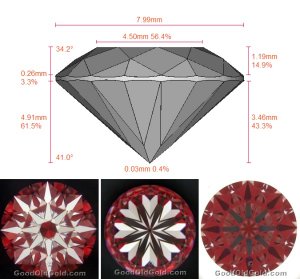- Joined
- Feb 26, 2003
- Messages
- 379
My latest article in the Journal of Gemmology speaks directly to most of this discussion. It explores the center of the sweet spot in Ideal round brilliant diamond cutting in all the seven dimensions currently being used to define the standard round brilliant (standard indexing, no painting or digging).
Interestingly, the geometric center of the AGS Ideal and the GIA Excellent sweet spots for pavilion, crown and table are closest to a 41 pavilion angle, 34 crown angle, and a 56% table, and not Tolkowsky’s angles of 40.75, 34.5 and 53%.
I found that the center of the 7-dimensional sweet spot for pavilion angle for Ideal or Excellent cutting was 41.2 for GIA and 41.1 for AGS. They agree within 0.1 on the pavilion angle center and within 0.25 on the corresponding best crown angle center of 34.
This sweet spot center of 41 and 34 agrees with my investigations based upon direct assessment of the diamond''s optical performance in typical illumination circumstances. The sweet spot center is also in agreement with the teaching of diamond cutters and diamond cutting institutions. Henry Morse in the 1860’s was the first to determine that a 41 pavilion angle was best for this most critical of the round brilliant’s parameters. Prior to 1860 and his work, 45 was believed to be best. (Remarkably, what was believed best back then was actually the worst when table sizes got large enough to make this point obvious).
“From the 1970’s the Institute for Technical Training in the Antwerp province of Belgium taught angle combinations of 41 and 34 - 34.2 (personal communication with 1977 graduate diamond cutter, Dirk Verbiest.) In the same time frame, but a continent away in Johannesburg, South Africa, the Katz Diamond Cutting Factory was teaching its apprentices to cut the Ideal Round Brilliant to a 41 pavilion main angle and a 33 to 35 crown main angle (pers. comm., P. Van Emmenis.)”
That is part of why I titled the article "The Accordance in Round Brilliant Diamond Cutting".
So if you want to split hairs, and we all do, I can say with confidence and a large body of evidence, that a 41 pavilion in combination with the appropriate crown angle and the other 5 parameters is superior to Tolkowsky’s theoretical 40.75 and 34.5.
That is why I explained to the USFG that Diamond Design was Tolkowsky''s attempt to validate with a math and
physics arguement why a 41 degree pavilion angle combined with a 34-35 degree crown angle gave the best brilliance and fire to the 58
facet standard round brilliant cut diamond.
Because his math showed 40.75 and 34.5 as best, it has taken over 80
years for diamond grading institutions to realise what American
diamond cutters learned from Henry Morse back in the 1860''s, that 41
degrees is the center of the Ideal cut pavilion angle, sweet spot,
not 40.75.
If you want Ideal Scope performance similar to and as good as Tolkowsky’s 40.75, 34.5, use 41 and 34. An added bonus is a slightly better yield from octohedral rough.
Ideal regards,
Michael Cowing






300x240.png)